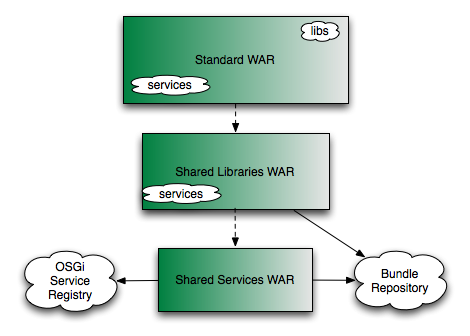Taking on a new technology such as OSGi may seem a bit daunting at first, but a proven set of migration steps can help ease the journey. Teams wishing to migrate existing applications to run on the SpringSource dm Server will find that their applications typically fall into one of the following categories.
Web Application: for web applications, this chapter provides an overview of the steps required to migrate from a Standard WAR to a Shared Services WAR. Furthermore, the following chapter provides a detailed case study involving the migration of the Spring 2.0 Form Tags show case application.
Anything else: for any other type of application, you will typically either deploy your application as multiple individual bundles, as a single PAR file, or as a plan, which is the recommended approach for deploying applications on the SpringSource dm Server. See Section 5.2, “Migrating to a Plan or a PAR” for details.
Many applications may start with the standard WAR format for web applications and gradually migrate to a more OSGi-oriented architecture. Since the SpringSource dm Server offers several benefits to all supported deployment formats, it provides a smooth migration path. Of course, depending on your application’s complexity and your experience with OSGi, you may choose to start immediately with an OSGi-based architecture.
If you are not yet familiar with OSGi or simply want to deploy an existing web application on the SpringSource dm Server, you can deploy a standard WAR and leverage the dm Server with a minimal learning curve. In fact reading the SpringSource dm Server User Guide is pretty much all that you need to do to get started. Furthermore, you will gain familiarity with the SpringSource dm Server, while preparing to take advantage of the other formats.
The Shared Libraries WAR format is the first step to reaping the benefits of OSGi. In this phase, you dip your toes into OSGi-based dependency management by removing JAR files from the WAR and declaring dependencies on corresponding OSGi bundles.
In this phase, you take the next step toward a fully OSGi-based architecture by separating your web artifacts (e.g., Servlets, Controllers, etc.) from the services they depend on.
The following diagram graphically depicts the migration path from a Standard WAR to a Shared Services WAR. As you can see, the libraries (libs) move from within the deployment artifact to the Bundle Repository. Similarly, the services move from within the WAR to external bundles and are accessed via the OSGi Service Registry. In addition, the overall footprint of the deployment artifact decreases as you move towards a Shared Services WAR.
